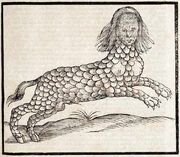
Lamia – Dictionnaire Infernal
In ancient Greek mythology, Lamia (Greek: Λάμια) was a beautiful queen of Libya

The Lamia: In this 1909 painting by Herbert James Draper, Lamia has human legs and a snakeskin around her waist. There is also a small snake on her right forearm.
who became a child-eating daemon. Aristophanes claimed her name derived from the Greek word for gullet (λαιμός; laimos), referring to her habit of devouring children.
In the myth, Lamia is a mistress of the god Zeus, causing Zeus' jealous wife, Hera, to kill all of Lamia's children (except for Scylla, who is herself cursed) and transform her into a monster that hunts and devours the children of others. Another version has Hera merely stealing away all of Lamia's children and it being Lamia herself, losing her mind from grief and despair, who starts stealing and devouring others' children out of envy, the repeated monstrosity of which transforms her into a monster on its own.
Some accounts say she has a serpent's tail below the waist. This popular description of her is largely due to Lamia, a poem by John Keats published in 1819. Antoninus Liberalis uses Lamia as an alternate name for the serpentine drakaina Sybaris; however, Diodorus Siculus describes her as having nothing more than a distorted face.
Later traditions referred to many lamiae; these were folkloric monsters similar to vampires and succubi that seduced young men and then fed on their blood.
In later stories, Lamia was cursed with the inability to close her eyes so that she would always obsess over the image of her dead children. Some accounts say Hera forced Lamia to devour her own children. Myths variously describe Lamia's monstrous (occasionally serpentine) appearance as a result of either Hera's wrath, the pain of grief, the madness that drove her to murder, or—in some rare versions—a natural result of being Hecate's daughter.
Zeus then gave her the ability to remove her eyes. The purpose of this ability is unclear in Diodorus, but other versions state Lamia's ability to remove her eyes came with the gift of prophecy. Zeus did this to appease Lamia in her grief over the loss of her children and to let her rest since she could not close her eyes.
Horace, in Ars Poetica (l.340) imagines the impossibility of retrieving the living children she has eaten: Neu pranse Lamiae vivum puerum extrabat alvo.Alexander Pope translates the line: Shall Lamia in our sight her sons devour, and give them back alive the self-same hour?Stesichorus identifies Lamia as a daughter of Poseidon and as the mother of Scylla by Phorcys. This might be a conflation of Lamia with the sea goddess Ceto, traditionally Phorcys's wife and mother of Scylla. Further passing references to Lamia were made by Strabo (i.II.8) and Aristotle (Ethics vii.5). Other sources cite Triton as having fathered Scylla by Lamia. Antoninus Liberalis identifies the dragon Sybaris with Lamia, another conflation.
Interpretations[]

Lamia (first version) by John William Waterhouse (1905); note the snakeskin wrapped around her arm and waist.
Mothers throughout Europe used to threaten their children with the story of Lamia. Leinweber states, "She became a kind of fairy-tale figure, used by mothers and nannies to induce good behavior among children."
Many lurid details were conjured up by later writers, assembled in the Suda, expanded upon in Renaissance poetry and collected in Bulfinch and in Brewer's Dictionary of Phrase and Fable: Lamia was envious of other mothers and ate their children. She was usually female, but Aristophanes suggests a hermaphroditic phallus, perhaps simply for monstrosity's sake. Leinweber notes, "By the time of Apuleius, not only were Lamia characteristics liberally mixed into popular notions of sorcery, but at some level the very names were interchangeable." Nicolas K. Kiessling compared the lamia with the medieval succubus and Grendel in Beowulf.
Apuleius, in The Golden Ass, describes the witch Meroe and her sister as lamiae: "The three major enchantresses of the novel — Meroe, Panthia and Pamphylia — also reveal many vampiric qualities generally associated with Lamiae," David Walter Leinweber has noticed.

Lamia (second version) by John William Waterhouse (1909); note the snakeskin on her lap.
One interpretation posits the Lamia may have been a seductress, as in Philostratus' Life of Apollonius of Tyana, where the philosopher Apollonius reveals to the young bridegroom, Menippus, his hastily-married wife is really a lamia, planning to devour him. Some harlots were named "Lamia". The connection between Demetrius Poliorcetes and the courtesan Lamia was notorious. In the painting by Herbert James Draper (1909, illustration above), the Lamia who moodily watches the serpent on her forearm appears to represent a hetaera. Although the lower body of Draper's Lamia is human, he alludes to her serpentine history by draping a shed snake skin about her waist. In Renaissance emblems, Lamia has the body of a serpent and the breasts and head of a woman, like the image of hypocrisy.
Christian writers warned against the seductive potential of lamiae. In his 9th-century treatise on divorce, Hincmar, archbishop of Reims, listed lamiae among the supernatural dangers that threatened marriages, and identified them with geniciales feminae, female reproductive spirits.
John Keats described the Lamia in Lamia and Other Poems, presenting a description of the various colors of Lamia that was based on Burton's in The Anatomy of Melancholy. The Keats story follows the general plotline of Philostratus, with Apollonius revealing Lamia's true nature before her wedding.

A 17th century depiction of Lamia from Edward Topsell's The History of Four-Footed Beasts
Modern folk traditions[]
In the modern Greek folk tradition, the Lamia has survived and retained many of her traditional attributes. John Cuthbert Lawson remarks "....the chief characteristics of the Lamiae, apart from their thirst for blood, are their uncleanliness, their gluttony, and their stupidity". The contemporary Greek proverb, "της Λάμιας τα σαρώματα" ("the Lamia's sweeping"), epitomises slovenliness; and the common expression, "τό παιδί τό 'πνιξε η Λάμια" ("the child has been strangled by the Lamia"), explains the sudden death of young children.